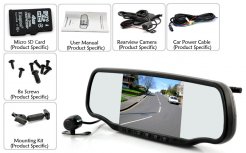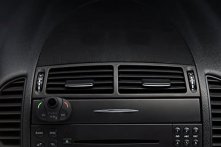Radar Speed Detectors for car

How Traffic Radar Works
Traffic radar uses a radar beam to measure speed. Think of the beam as a searchlight. It’s invisible because it’s made of microwaves instead of light, but otherwise it acts very much like a light beam. It travels in straight lines. It’s easily reflected. It scatters as it is passed through dust and moisture in the air. And — this is essential — it has to hit your
car before it can determine your speed.
Radar can’t see around corners or through hills. It can’t see you when you are behind another vehicle. When in the clear, how strongly your vehicle reflects determines how far the radar can read your speed. Generally, larger vehicles reflect more strongly than smaller vehicles. Trucks are “visible” on radar farther away than cars.
The principle on which radar operates is absolutely reliable. Radar equipment, on the other hand, is only as good as the quality of its design and manufacture. Traffic radars tend to be unreliable. They’re cheaply made and therefore vulnerable to many interferences that cause false readings. And, compared to the military and weather radar which have rotating antennas, traffic radars are vastly simplified. This simplification means that traffic radar cannot tell one car from another. The operator has to do that, and since the operator can’t see an invisible beam any better than you can, he frequently doesn’t know which vehicle’s speed is being read. This is a source of many undeserved tickets.
How Radar Detectors Work
A radar detector works like a radio tuned to microwave frequencies. Valentine One is an extremely sensitive radio, and it’s tuned exactly to the frequency bands used by all traffic radar in the U.S. — X band, K band, Ka Band, which includes photo. Moreover, it has two antennas, one aimed forward and one rearward, so that it can locate the radar. Because Valentine One is so sensitive, it can easily find radar from the scattering of the beam, and it can find these scatters a long time before the actual beam hits your car. The only exception is Instant-on radar.
How Instant-on (Pulse) Radar Works
As a defense against detectors, many radar units can be operated in the Instant-on mode, also called the Pulse mode. This means the radar is in position, but it is not transmitting a beam. So it cannot be detected. When the target is within range, the radar operator switches on the beam and the radar calculates the speed, usually in less than a second. This calculation happens too quickly for the target (you) to respond in time. Still, you can defend against Instant-on by recognizing it when the operator zaps traffic ahead of you. Valentine One’s great sensitivity — and your attention to the nuances of its warnings — gives you at least a sporting chance.
The Difference Between X Band and the K Bands
X-band alerts (“Beep”) are often found at long distances. K and Ka bands are usually detected at closer range, and alerts on those frequencies are much more likely to be radar. So Valentine One makes a different sound (“Brap”) to warn you of these more urgent threats (bogeys).
What are False Alarms
Since all radar detectors are simply radios tuned to the microwave frequencies used by traffic radar, they automatically sound their alert whenever they encounter signals on those frequencies. The problem is, other devices that are not radar are also operating on radar frequencies. A detecting radio must respond to them too. Every response indicates a threat, a bogey. How can you tell the difference between radar and what people commonly refer to as false alarms? Your judgment is the only way. But here are the basics:
- X band: A catch-all band, still used regularly in some areas by traffic radar, but heavily populated by sensors for supermarket automatic doors and other nuisance signals. In shopping areas, expect door sensors. But know the territory. Unless you’re sure that X band is not used locally for radar, stay alert until you’ve identified the bogey.
- K band: Maybe radar, maybe...
|
Car Radar and Laser Detector, SQdeal 16 Band Laser/Radar Detector Voice Alert Car Speed Alarm System with 360 Degree Detection, City/Highway Mode, Bright LED Display Car Audio or Theater (SQdeal)
|
|
|
Laser/Radar Detector, 16 Band Signal Voice Alert Car Speed Alarm System with 360 Degree Detection, VG-2 Immunity, City/Highway Mode, Auto Mute, Bright LED Display - JVR AO26 Car Audio or Theater (JVR Online)
|
Related posts:

 Going to the cinema is becoming an increasingly less popular pastime. The rise of online streaming services such as Netflix , Amazon Prime and MUBI mean that you…
Going to the cinema is becoming an increasingly less popular pastime. The rise of online streaming services such as Netflix , Amazon Prime and MUBI mean that you… Charge the battery from the lighter! The Battery Tender Cigarette Lighter Adapter allows you to charge your vehicle s 12 volt battery by connecting the Battery Tender…
Charge the battery from the lighter! The Battery Tender Cigarette Lighter Adapter allows you to charge your vehicle s 12 volt battery by connecting the Battery Tender… Being pulled over by a police officer for speeding is the beginning of a series of unfortunate events that costs people money and time, at the very least. Smart…
Being pulled over by a police officer for speeding is the beginning of a series of unfortunate events that costs people money and time, at the very least. Smart… Q7 HUD GPS Head Up Display! Q7 HUD is specially designed for preventing accident, which can project important information ( e.g. vehicle speed ) onto the front windshield…
Q7 HUD GPS Head Up Display! Q7 HUD is specially designed for preventing accident, which can project important information ( e.g. vehicle speed ) onto the front windshield… In need of a portable battery? These phone chargers will keep your smartphone fully charged all day long. Our list includes phone chargers that will work for iOS…
In need of a portable battery? These phone chargers will keep your smartphone fully charged all day long. Our list includes phone chargers that will work for iOS…